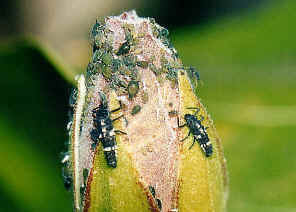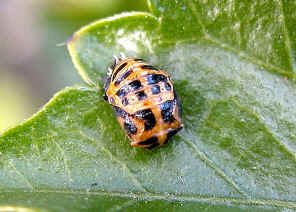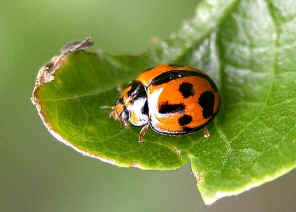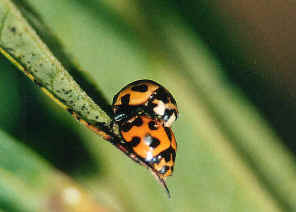Variable Ladybird Beetles - Coellophora inaequalis
FAMILY COCCINELLIDAE
This page contains information and pictures about Variable Ladybird Beetles that we found in the Brisbane area, Queensland, Australia.

- Body length 5mm
- For every colony of the Milkweed Aphids we found, we always see this ladybirds hiding somewhere nearby.


- The ladybirds are bright orange-yellow in colour with four various pattern black dot on each wing-covers. There is a black line at the meeting edges of the wing-covers. The dot patterns are various between individual.


- In the first picture, the ladybird adult just catch a Milkweed Aphid and looking for a place to eat it. The Milkweed Aphids suck the juice of milkweed so we believe they are toxic. The ladybird must have evolved the solution to overcome the toxic. The second picture show two ladybird larvae hunting the Cowpea Aphids on Hibiscus. Usually we can find both adult and larva hunting on the same plant.
In our backyard, we have a red flower Hibiscus plant. In early spring, the number of aphids build up. A week later the ladybirds come and very soon the number of aphids under control.
The ladybird female are about the same size , or a bit larger than the male. After mating, the female lay a batch of eggs, about ten, on the leaf surface.
About a week, the larvae hatch from the eggs. They are black in colour and may be mistaken as ants. They start to look for the aphids as their first meal. Some other insect larvae consume their eggs shells just after hatched as their first meal. The ladybird larvae do not do that. We also found that ladybird larvae do not eat their molted skin in all instars stage.


- Later instars, length 8mm, 10mm
- A ladybird larva is not as easily identified as the adults. Different species may look similar. Ladybird larvae do not resemble adults. They are soft-bodied and are variously coloured with spots and are adorned with spines. Their short legs protrude out from their elongate bodies, which are often dark with brightly colored markings. As in the pictures above, larvae are usually found in aphid colonies.


- The pupa has the same colour as adult. The pupa took about 8 days in summer to turn into an adults.


- We do not notice if Adults ladybird beetles have any predators . However, they do have predators which feed on their soft- bodied larvae. The picture shows a Assassin bug feeding the ladybird larvae on a Milkweed plant. We found this bug when we studying the ladybird larvae as predator on aphids. Somehow the ladybird larvae became the prey.
The adult Variable Ladybirds are medium in size compare with other ladybird beetles. On each wings there are four irregular sharp dots. Those dot are different between individual.
They can be looked quite different, as show in the above second pictures and pictures below.
We do not think this bend-patterned ladybird is a Variable Ladybird.......... until we saw the mating couple.


- Reference:
- 1. 九星瓢蟲 - Insects of Taiwan.
- 1. 九星瓢蟲 - Insects of Taiwan.










